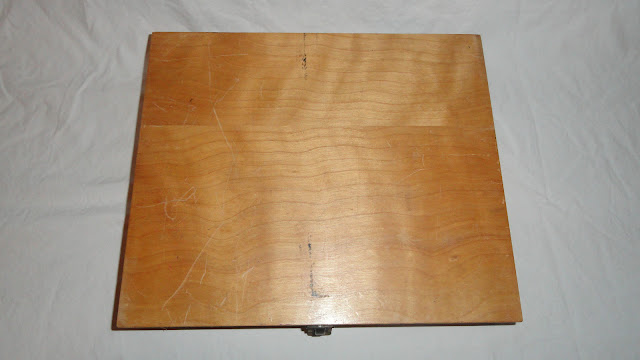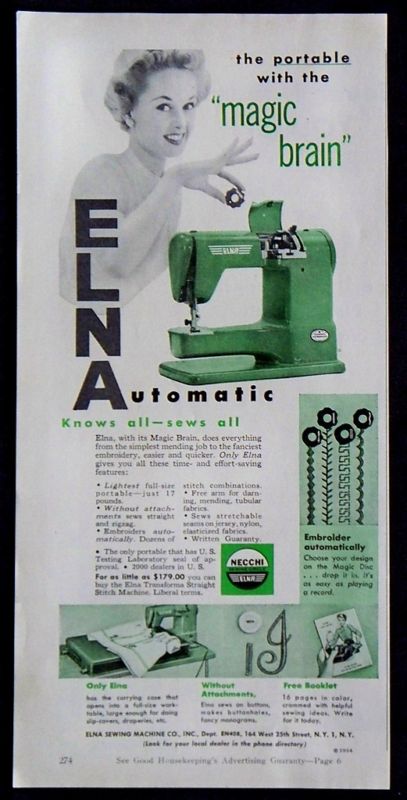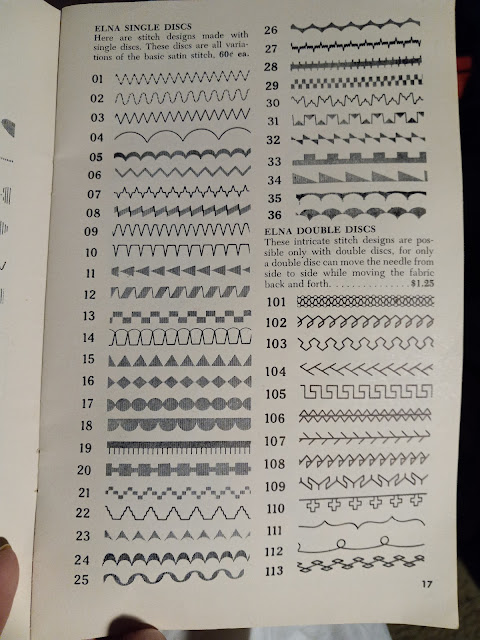ELNA SUPERMATIC SEWING MACHINES
ELNA SUPERMATIC
The Automatic zigzag Sewing Machine BEFORE computers!
What is the difference between an "AUTOMATIC" sewing machine, and a semi automatic sewing machine? Most manufacturers described early zigzag sewing machines, which had the capability of sewing various widths of zigzag stitches, as semi automatic, though some claimed their machines were "automatic", when the zigzag stitch width actually had to be manually manipulated, to create curving, decorative stitches. Classes were taught, showing buyers how to make their regular zigzag sewing machine, sew beautiful monograms, flowers, vines, sparkle stitches, etc., but those were NOT truly "AUTOMATIC" zigzag sewing machines, like these INCREDIBLE Elna Supermatic sewing machines!
Elna made 102 different stitch cams, not counting the buttonhole cam. I came up with this number, counting cams 1-36, plus 101-166 (the newest chart # for cams, that I have.)
If you have the Star cam models, you can make more stitches than this, combining built in stitches with the cams, as shown in the manual, and on newer stitchcharts.
Elna made their SUPER Automatic sewing machines, take special plastic stitch cams, which can be inserted into the "computer brain", to tell the machine when to sew larger or smaller zigzag stitches, or even straight stitches, in special designs, without the sewer having to do anything more than load the fabric into the machine, and push the knee control, to begin sewing absolutely beautiful stitches! Initially, it was simply zigzag stitches, but quickly, the "stretch" stitch double cams were designed, which allows the Supermatic to sew everything from super stretch stitches, to flowers, stars, fish, birds, geese, dogs, cats, sailboats, & a multitude of stitches, for every possible sewing task!
My favorite convenient Elna Features-
183+ different stitch cams available
Multiple needle positions
TWIN NEEDLE accessory, uses regular needles, to sew coverstitch look hems or double embroidery!
Stitch width & length controls allow you ability to adjust stitch designs to fit your creativity
Reverse stitches as short or as long of stitches as you like, locks stitches securely
Sew as fast as 1550 stitches per minute or slow as you like, quiet & smooth if kept clean & oiled properly
Freearm or flatbed
lightweight, yet incredibly strong full size machine!
Portable METAL case screws to attach machine, for safe travel, becomes EXTENSION TABLE if wanted!
Organized accessory case stores under freearm, inside case
Kneebar control - No runaway pedal
Stretch stitches, embroidery stitches, utility stitches
darning plate & embroidery capability
sew buttons & hooks & eyes on by machine!
eyelet plates available in 2 sizes
extra long basting stitch plate available (Turns zigzag stitch into long straight basting stitch)
Straight stitch needle plate available to protect light fabrics like satin & silk
Well designed presser feet available for everything from pintucking, to binding, ruffling, shirring, embroidery, rolled hems in several sizes, flat feld foot, topstitching with guide, & more...
Low shank presser feet widely available to fit machines
Manuals instruct in darning, embroidery, as well as regular sewing, teach very well
Embroidery & fine sewing idea books to show how to use your Elna best
Automatic buttonhole cam available, & special buttonhole gauge foot
Friction pulley instead of belt system, lasts 40 to 60 years before needing replaced
Drop in bobbin easy to change in the middle of project, if needed
BEAUTIFUL HIGH QUALITY STITCHES!
European zig zag machines seem to keep the needles side to side movement better controlled, with less needle strikes on the throat plates than other "swing needle" machines
Incredibly well designed & well built, a machine to last centuries, if well cared for, a real heirloom treasure!
Easy access to clean & oil yourself
183+ different stitch cams available
Multiple needle positions
TWIN NEEDLE accessory, uses regular needles, to sew coverstitch look hems or double embroidery!
Stitch width & length controls allow you ability to adjust stitch designs to fit your creativity
Reverse stitches as short or as long of stitches as you like, locks stitches securely
Sew as fast as 1550 stitches per minute or slow as you like, quiet & smooth if kept clean & oiled properly
Freearm or flatbed
lightweight, yet incredibly strong full size machine!
Portable METAL case screws to attach machine, for safe travel, becomes EXTENSION TABLE if wanted!
Organized accessory case stores under freearm, inside case
Kneebar control - No runaway pedal
Stretch stitches, embroidery stitches, utility stitches
darning plate & embroidery capability
sew buttons & hooks & eyes on by machine!
eyelet plates available in 2 sizes
extra long basting stitch plate available (Turns zigzag stitch into long straight basting stitch)
Straight stitch needle plate available to protect light fabrics like satin & silk
Well designed presser feet available for everything from pintucking, to binding, ruffling, shirring, embroidery, rolled hems in several sizes, flat feld foot, topstitching with guide, & more...
Low shank presser feet widely available to fit machines
Manuals instruct in darning, embroidery, as well as regular sewing, teach very well
Embroidery & fine sewing idea books to show how to use your Elna best
Automatic buttonhole cam available, & special buttonhole gauge foot
Friction pulley instead of belt system, lasts 40 to 60 years before needing replaced
Drop in bobbin easy to change in the middle of project, if needed
BEAUTIFUL HIGH QUALITY STITCHES!
European zig zag machines seem to keep the needles side to side movement better controlled, with less needle strikes on the throat plates than other "swing needle" machines
Incredibly well designed & well built, a machine to last centuries, if well cared for, a real heirloom treasure!
Easy access to clean & oil yourself
ELNA bobbin part #503855 is actually shorter than the class 15 Necchi bobbin on the right, in this Necchi Elna catalog. Notice the Elna bobbin has 7 holes on the top, but is solid on the bottom. It is taller than a Singer class 66 bobbin (one of my Elna Supermatics only had Singer class 66 bobbins with it, and in it, when I bought it), which people often mistakenly use, if they can't find Elna bobbins, but especially if you sew fast, with a class 66 bobbin, in an elna, it will jam, sewing the bobbin to the machine. It is best if you can find original Swiss made Elna bobbins, for your Elna sewing machine.
 |
| Elna Feet and accessories usually say SWISS MADE |
 |
| Singer low shank snap on presser foot shown in closer detail, in case you choose to try this for your Elna too. |
 |
| Elna Monogrammer with the embroidery ring 226 |
 |
| Elna Mongrammer and instruction sheet |
 |
| Elna Monogrammer in packet, Elna Circular Sewing Device 222 |
 |
| Advertising flyer for Elna Circular Sewing Device 222 and Monogrammer Attachment 226 |
    |
 |
| PLUG the cord INTO the base of the Supermatic |
 |
| to protect the plug from getting caught in the case |
Elna Supermatic Sewing Machines
Elna Supermatic with spring releasing cam mechanism
ELNA HISTORY NEEDLEBARELNA BASTING PLATE and TOPSTITCH ACCESSORY
 |
| Elna Supermatic Basting Stitch Plate, cam 150, settings for 1mm, 2mm, 3mm, 4mm (1 1/4") black thread on top, white thread on bottom, but it's hard to see the basting stitches, but they are PERFECT for fitting, or temporary stitches, easy to remove, when you don't need them anymore. Notice the skinny metal straw, or pipe on the underside of needleplate. |
 |
| Elna Guide to Creative Sewing was a way for customers to see which all stitch cams were available, & to teach them some design ideas, to help them use those designs, in their home sewing. |
 |
| The photos of stitch samples, really helped customers to have an idea what their finished stitch designs would look, so they could plan decorative design series, to show what they should look like, if the machine was properly adjusted. |

This vintage flyer shows up close detail of some of the Supermatic's special features & stitch cams
Freearm sewing machines make it so much easier to sew around narrow cuffs, pant leg hems, necklines, armholes, & other sewing work that is small & circular, in particular, for darning nylons & socks, just by slipping them over the arm! I read that the man who designed the freearm, actually measured the ankles of women at train stations all over the country, to make sure they designed the freearm small enough, ladies could slip their dainty socks over it!
This doesn't mean you are stuck using a narrow freearm all of the time you are sewing, because the Tavaro Swiss company had the genius idea of making their machines not only freearms, but PORTABLE! These early Elna Supermatic sewing machines came with a light but sturdy metal case, which the machine can actually be screwed down to, securely, for safe travel, but the case itself unfolds, then slips around the freearm, creating a large, flat sewing surface, perfect for sewing quilts & other large projects, with perfect control & support!
Elna included an ingenious accessory & feet organizer, or toolbox (several designs over the years), which slip under the freearm for storage, but holds your bobbins, spools of thread, several presser feet, needles, as well as several stitch cams!
ELNA CAM STORAGE CASES
 |
| Elna Wooden Cam Case closed |
 |
Elna Wooden Cam Case |
 |
| Elna plastic cam storage containers ad |
 |
| Elna cam case clear plastic for 12 cams |
 |
| Elna Dealership & Sewing Class Stitch Sampler |
 |
| Elna Dealership & Sewing Class Stitch Samplera |
 |
| Elna Dealership & Sewing Class Stitch Sampler |
 |
| Elna Dealership & Sewing Class Stitch Sampler |


 |
| Elna Dealership & Sewing Class Stitch Samplerb |
 |
| Elna Dealership & Sewing Class Stitch Samplerc |
 |
| Elna Dealership & Sewing Class Stitch Samplerd |
 |
| Elna Dealership & Sewing Class Stitch Samplere |
 |
| Necchi & Elna were sold by the same dealers, which is why you will find most catalogs for Necchi & Elna sewing machine accessories & parts, are jointly printed, like my Necchi Elna catalog |


BPSsBJJe7Q~~60_57.JPG)
Mono Graph & Monogrammer for Elnas are also available. You place the photo or monogram you want to copy in the right circle, & stitch in the left one. As you follow the lines, your machine stitches a copy. Not quite as easy as computers, though...
ELNA FRICTION PULLEYS
Notice the little wad of black stuff, almost in the center of this photo? This was the rubber on the outside of the friction pulley, that drives the machine, instead of the usual rubber belt. The seller said the machine worked great, but had a vibration, & the needle doesn't always move when you push the controller, until they turned the hand wheel manually. As soon as I tried the machine the first time, the rubber peeled itself off, & fell down inside the machine, eventually winding up here, so I could clean it out, before it caused any other trouble! Yes, there are some nylon or other plastic type gears in these machines, just like the Bernina's, which are also Swiss Made. While they can fail, they usually allow quieter, smoother running, even at high speeds.
Beware of techs who claim it isn't fixable, & volunteer to throw it out for you. Take it back & part it out yourself, if you really can't afford to get it repaired. There are a lot of free online groups who help each other learn to repair & maintain & use these vintage treasures, & some techs just want to part it out or sell it online. Obviously repair techs aren't all crooks, but too many are, & Ebay has made this kind of pirating, profitable.

May you get lucky & find one of these treasures yourself. Yes, even if they need their pulley replaced, I do think the Elna Supermatic & other automatic cam stitch Elnas are worth the trouble to fix! Happy Sewing!
Here are some links to places to buy replacement friction Pulleys
Dave Mannock, a member of a Facebook sewing machine group, sells these here-
https://www.facebook.com/pg/Bits-Bobs-New-Necchi-Other-VSM-parts-448105408896021/photos/?tab=album&album_id=514631165576778
REMEMBER- Be aware, this is NOT an industrial sewing machine, even though some people do sell them, claiming they are industrial sewing machines. Compared to today's plastic sewing machines, these metal machines are heavy duty, and the term "industrial strength" is literally an opinion, or someone's advertising description, it means they think it seems as strong as an industrial machine, it does not mean that it really is an industrial sewing machine.
ELNA HISTORY & other great Elna related sites that I enjoy-
http://needlebar.org/main/elna/
http://www.mckennalinn.com/elna-grasshopper-bobbin.html
 |
| Elna Automatic only took the flat, single layer cams, but was still a fully automatic zigzag sewing machine. All of the other Elna cam taking sewing machines can use both the single layer cams, and the double layer cams |

| ||













.JPG)





































